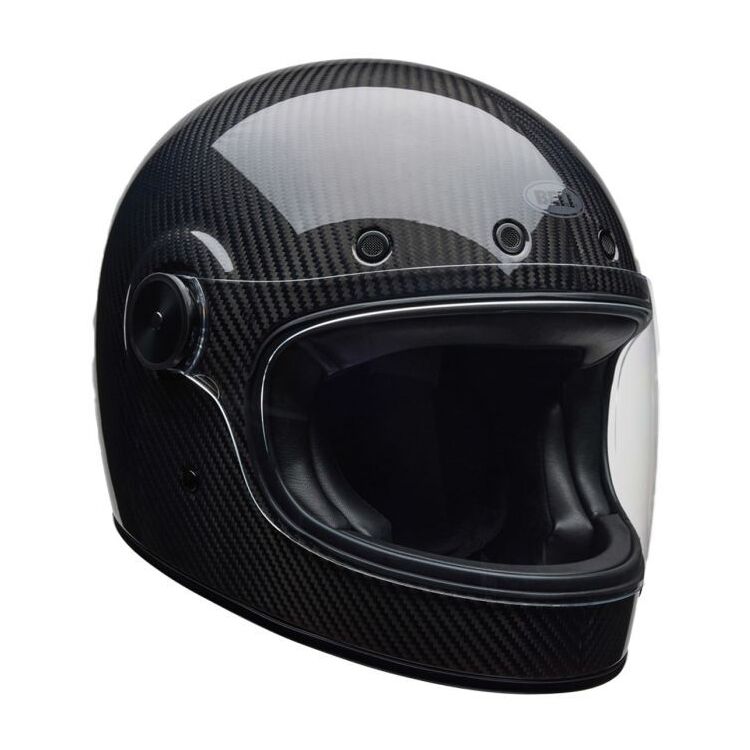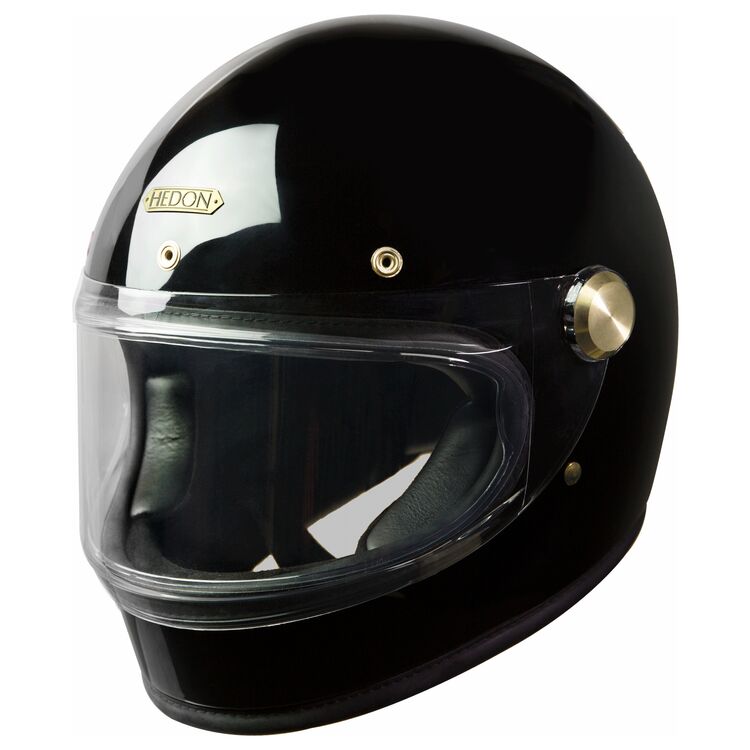
Bell Bullitt Helmet Review: Retro Looks, Modern Protection
left for contents
I bought my first Bell Bullitt way back in 2017. And after working in the motorcycle gear industry for Ducati New York and Triumph Brooklyn for as many years, I’m still happy with my choice.
Here are a few things about the Bullitt that might surprise you.
- While it looks like it beamed straight outta the 70s, its comfort is surprisingly modern, but that comfort comes with a catch on longer rides.
- That giant viewport is amazing for seeing the world, maybe too amazing when it comes to hearing it.
- The Bullitt is built like a premium piece of gear, but its ventilation sometimes feels more vintage than the look itself.
If you’re looking for a retro helmet to ride around the city in, this is likely it. If you’re looking for more… stick around and let me tell you what else you should look at.
The Bell Bullitt GT updates a retro icon with ECE 22.06/DOT safety, a wider eye port, tighter gasket, and better vents. Plush liner, eyewear-friendly fit, and large speaker pockets make it comfortable and comms-ready for stylish daily rides and touring.
- DOT & ECE 22.06 certified
- Wide panoramic viewport
- Improved vents and gasket
- Comms-ready speaker pockets
- Loud at highway speeds
- No Pinlock; fogs in cold/wet
You can also view this review in video format below.
My History with the Bullitt
My journey with the Bullitt started way back in 2017. It was actually my first real helmet purchase after getting into riding more seriously.
Like many of you, the look grabbed me immediately.

It just screamed classic cool, a perfect match for the vintage-inspired bikes I loved. Working the floor at Ducati New York and later Triumph Brooklyn, I saw countless helmets come and go.
As the apparel and gear manager at both shops, I got my hands on everything, fitting customers, hearing feedback, and seeing what held up.
Through all that, the Bullitt remained a personal favorite, at least for certain kinds of riding. I’ve probably tried on or ridden in dozens of helmets over the years – from super-modern race lids like Arais to practical modulars like a Schuberth C5, and other retro options like the Biltwell Gringo SV or the Hedon Heroine.

Each has its place, but the Bullitt occupies a unique spot. It’s not just an Instagram prop, it works on the road as well as a modern helmet. And trust me, my Bullitt has seen plenty of road.
Putting the Bullitt Through Its Paces
I’ve put this helmet through its paces across NYC and beyond. Let me walk you through how it held up.
City Streets: Where the Bullitt Truly Shines
First up: navigating the concrete jungle of NYC. This is where the Bullitt absolutely shines. The visibility is just phenomenal. That massive eyeport gives you a field of vision that feels incredibly open, almost like wearing an open-face helmet but with actual chin protection.

Spotting taxis trying to cut you off, pedestrians stepping out, potholes appearing from nowhere – you see it all without craning your neck constantly.
Compared to some sportier helmets with narrower viewports designed for a tuck position, the Bullitt feels liberating for upright, urban riding. It makes head-checks quicker and easier, which is a massive confidence booster in chaotic traffic.
Highway Hauls: Brace for the Noise!
Okay, scenario two: hitting the highway. Let’s be real honest here – this is not the Bullitt’s natural habitat. It’s not the quietest helmet on the market. Not by a long shot. Once you push past 65 mph, the wind noise becomes pretty noticeable.

That huge viewport that’s so great in the city? It catches the wind. The retro design, while gorgeous, isn’t optimized for slicing silently through the air at high speeds. You’ll definitely want a good set of earplugs for any sustained highway cruising.
It’s manageable, but if your rides regularly involve long stretches above 70 mph, there are quieter helmets out there.
Caught in the Rain: How Does it Handle Weather?
Third, let’s talk rain. Caught in a downpour? The Bullitt holds its own, mostly.
The standard flat shield seals reasonably well against the gasket, keeping most water out. The visor comes with an anti-fog coating, which does a decent job in mild conditions or when you’re moving.
However, there’s no Pinlock insert included, and no option for one directly from Bell for this shield style. In really cold, damp weather, especially when you’re stopped at a light, you will experience some fogging.
Cracking the visor helps, but it’s not ideal in heavy rain. For fair-weather riders or those in warmer climates, it’s less of an issue. For dedicated all-weather commuters in chilly regions, the lack of a Pinlock is a definite consideration.
After Dark: Riding the Bullitt at Night
Fourth on the list: night rides. Visibility out of the helmet remains great, obviously. The clear shield is optically sound, no weird distortions under streetlights.
Bell also incorporates some subtle reflective details into the helmet’s design – often in the trim or logos depending on the specific colorway.
They aren’t massive reflective panels, but every little bit helps when you’re trying to be seen after dark. It’s a nice touch that blends in with the aesthetic.
The Daily Grind: Commuting Comfort (and Weight)
And fifth, the everyday commute. This blends city riding, maybe some slower highway stretches, and overall comfort.
The interior padding is genuinely plush. Bell uses high-quality materials, often featuring genuine leather and soft suede-like fabrics, especially on the Carbon versions. It feels premium against your skin.

The fit, for me, has always been true to size, though it’s known to be quite snug in the cheeks initially – expect a break-in period for those pads to contour to your face.
But here’s the flip side I mentioned earlier: the weight. While the Carbon version shaves off some grams (tipping the scales around 1280g +/- 50g for a size M), even it isn’t the lightest lid available.
After an hour or two, especially if you’re sensitive to neck fatigue, you start to notice that weight. It’s not unbearable, but it’s present.
For shorter hops and commutes, it’s perfectly fine. For all-day touring? Maybe not the first choice based on weight alone.
What I Love About the Bullitt
So, what do I genuinely like about the Bell Bullitt after all this time?
Design
Number one, unquestionably, is the design. Let’s face it, this is probably why you’re reading this review. It’s one of the best-looking retro helmets ever made, period. Inspired by the original Bell Star from the 60s, it nails that vintage aesthetic while meeting modern safety standards (DOT and ECE certified).

Whether you go for a solid color, a graphic version, or the premium Carbon finish, it just looks right on a classic bike, a cafe racer, or a modern classic. The attention to detail, like the metal mesh vents and the clean lines, makes it a standout piece.
Visibility
Number two is that visibility. I mentioned it in the city riding context, but it bears repeating. That huge field of view is fantastic. It genuinely enhances situational awareness, making rides feel safer and more connected to your surroundings.
It feels less claustrophobic than many other full-face helmets, offering a near open-face experience with full-face protection.
Comfort
Number three has to be the interior comfort and feel. Slipping on the Bullitt, especially a Carbon model with its leather and suede liner, feels luxurious. The padding is soft, the materials feel high-quality, and it contributes to that overall premium experience.
It’s well put-together, and the liner is removable and washable, which is more than I can say for many retro helmets. You really feel like you’re wearing a quality piece of kit.
Downsides
Now, for the things I don’t love as much. Every piece of gear has compromises, right?
Weight
First, as I touched on, it’s a bit heavy. The standard fiberglass Bullitt is noticeably heavier than the Carbon version. Even the Carbon, while lighter, isn’t featherweight compared to some modern, high-end composite helmets.

You’ll feel it most after an hour or more in the saddle. If you struggle with neck fatigue or plan on very long riding days, this is something to seriously consider. The lightness of the Carbon (around 1280g) is a definite plus over the standard version if weight is a concern, but you pay a premium for it.
Wind Noise
Second is the wind noise. Again, this is the trade-off for that awesome look and wide viewport. Aerodynamically, it’s not the slickest design. Above city speeds, it gets loud.
Earplugs become your best friend on any ride involving speeds over 60-65 mph. If you prioritize a quiet ride above all else, the Bullitt probably isn’t your helmet.
Lack of Pinlock
Third is the lack of a Pinlock-ready shield. That anti-fog coating works okay in many situations, but it’s no match for a Pinlock insert in truly cold or humid conditions where fogging becomes persistent.
Having to constantly crack the visor open at stops in bad weather gets old fast. For riders who face those conditions regularly, this is a significant drawback and might require looking at aftermarket solutions or different helmets entirely.
Need to Knows
Let’s cover a few other “Need to Knows.”
Sizing
Sizing is crucial for any motorcycle helmet to do its job and be comfortable. The Bullitt generally fits true to size based on Bell’s chart, but it uses an intermediate oval head shape. The most common feedback is that the cheek pads are very snug when new.
They do break in over time, molding to your face, but be prepared for that initial tightness. If you’re between sizes, trying one on is highly recommended, or be prepared to potentially swap cheek pads (Bell often sells different thickness pads).

It comes in 3 shell and EPS sizes, which helps ensure a more proportional fit and look across the size range, avoiding that “bobblehead” look.
Ventilation
Ventilation is another area where the retro design dictates function. You’ve got those cool-looking circular metal mesh vents on the chin bar and small exhaust vents out back.
There’s also a brow vent integrated into the trim on most models. Honestly? The airflow isn’t massive. At low city speeds, you won’t feel a ton of air moving through.

Once you get up to speed, you get some airflow, but it’s not comparable to modern helmets with large, scoop-style vents. It’s adequate for most conditions, but on scorching hot days stuck in traffic, it can get a bit warm inside.
Visor System
And the visor system? It uses a unique shield pivot mechanism with a magnetic tab closure on the left side.
Changing shields is straightforward – usually just a single coin-slotted screw on the side pivot. However, the opening and closing action isn’t as smooth or refined as the multi-detent systems on many contemporary helmets.

The magnetic tab holds the shield closed securely enough for normal riding, but it doesn’t “lock” down in the same way a mechanical latch does. It works, it fits the aesthetic, but it feels a bit less sophisticated than modern shield systems.
The Carbon versions come with both a clear flat shield installed and a flat dark smoke shield in the box, which is a nice value-add.
Bubble shields are also a popular option for leaning even harder into the vintage look. Don’t forget the integrated speaker pockets either, a nod to modern needs in this classic design.
The Competition
How does the Bullitt stack up against the competition?
VS Hedon Heroine
Let’s look at the Hedon Heroine Racer. If the Bullitt feels premium, the Hedon takes it up another notch. Think handcrafted luxury. The fit is often described as even more plush, the materials are top-tier (leather, brass/copper hardware), and the finish is exquisite.
However, this comes at a significantly higher price point. Ventilation might be even more limited than the Bullitt, and the overall style, while retro, is distinct. It’s for the rider who wants ultimate retro luxury and is willing to pay for it.
Hedon Heroine blends boutique craftsmanship with everyday ride comfort. A sleek composite shell, hand-stitched leather lining, and a wide, secure visor deliver refined style and clear vision. Quiet aerodynamics and a snug, balanced fit suit city commutes and relaxed weekend rides.
- Luxurious leather/suede interior
- Low-profile, elegant silhouette
- Wide visor with smooth mechanism
- Balanced fit feels stable
- Limited ventilation in hot weather
- Premium price for the finish
VS Arai Defiant-X
Then there’s the Arai Defiant-X (or its successor, the Contour-X/Quantic depending on region). Arai is legendary for safety, comfort, and ventilation. The Defiant-X/Contour-X has a retro-ish vibe, particularly in certain colorways, but it’s packed with modern Arai features like their VAS shield system, excellent ventilation, and renowned comfort.
It will likely be quieter and flow more air than the Bullitt, and Arai’s reputation for protection is second to none.
The downside? It can be harder to find, often carries a premium price tag (though sometimes similar to the Bullitt Carbon), and the styling is perhaps less purely “vintage” than the Bullitt.
Arai Defiant-X targets upright riders with a hand-built PB-cLc shell, Snell/DOT safety, and a generous eyeport. VAS-V Max-Vision shield accepts Pinlock; 13-point ventilation boosts airflow for nakeds/cruisers. Intermediate-oval fit with peel-away foam fine-tunes comfort.
- Snell/DOT-rated protection
- Aggressive airflow for upright bikes
- VAS-V shield; Pinlock-ready (often included)
- Fit-tunable pads and premium build
- A bit heavy and only average noise control
- No built-in sun visor
VS Biltwell Gringo SV
A closer competitor, especially on price for the standard Bullitt, is the Biltwell Gringo SV. Biltwell really updated their popular Gringo line with the SV model. It keeps that round, retro shell shape but adds functional ventilation (adjustable chin and forehead vents, rear exhausts) and comes with a modern, easy-to-change shield system.
It meets ECE 22.06 standards, offers good comfort, and comes in at a much more accessible price point than the Bullitt Carbon, and often less than the standard Bullitt too.
The interior might not feel quite as luxurious as the Bullitt, but it offers a fantastic blend of retro style and modern features for the money. It’s a very compelling alternative if the Bullitt’s price or specific drawbacks (like ventilation) are concerns.
The Biltwell Gringo ECE 22.06 Helmet combines vintage aesthetics with modern safety standards, offering riders a minimalist design without compromising on protection.
- Stylish retro look
- ECE 22.06 safety rated
- Comfortable interior
- No built-in visor
Is the Bell Bullitt Right For You?
So, after all these years, all the miles, and seeing everything else out there, is the Bell Bullitt still worth it?
My answer is a qualified yes. It depends entirely on what you prioritize.

If you ride a vintage machine, a cafe racer, a scrambler, or a modern classic, and you want a helmet that perfectly complements the look of your bike, the Bullitt is still arguably the king of style.
It looks fantastic, feels premium inside, and offers that incredible field of vision which is a huge plus for urban riding and generally enjoying the scenery.
The Carbon version, in particular, with its lighter weight (around 1280g +/- 50g for a Medium), beautiful finish, and industry-leading carbon composite shell, is a genuinely desirable piece of gear. It has that iconic status for a reason.
The Bell Bullitt GT updates a retro icon with ECE 22.06/DOT safety, a wider eye port, tighter gasket, and better vents. Plush liner, eyewear-friendly fit, and large speaker pockets make it comfortable and comms-ready for stylish daily rides and touring.
- DOT & ECE 22.06 certified
- Wide panoramic viewport
- Improved vents and gasket
- Comms-ready speaker pockets
- Loud at highway speeds
- No Pinlock; fogs in cold/wet
However, if your priorities lean towards long-distance comfort (especially regarding weight and noise), maximum ventilation for hot climates, or the absolute latest features like integrated comms systems or Pinlock visors as standard, then the Bullitt might not be the ideal choice. You might want to consider looking at other top-rated helmets.
The Bullitt’s strengths lie in its aesthetic, its quality build (meeting DOT and ECE standards with multi-density EPS liners), and its unparalleled viewport for certain types of riding. Its weaknesses are the noise at speed, the moderate ventilation, the lack of a Pinlock, and the weight, especially of the standard version.
Ultimately, the Bell Bullitt remains a fantastic helmet for its target audience: riders who value classic style highly and are willing to accept a few functional compromises to achieve that look. It’s comfortable for shorter rides and commutes, offers good protection, and that view… you really can’t beat that view.
It’s a helmet that makes you feel cool riding, and sometimes, that’s a big part of the enjoyment. It’s certainly kept me coming back to it for city riding since 2017.
Would you rock a Bell Bullitt? Or do you have one already? What are your thoughts? Drop a comment below and let’s talk!
Related

Carbon Fiber Modular Helmets: Ultimate Flip-Up Lids
Discover carbon fiber modular helmets that deliver flip-up convenience, lightweight strength, and serious protection for every ride.






